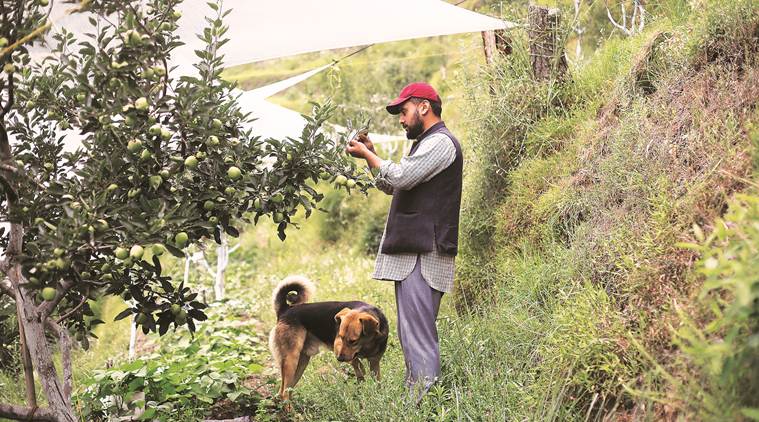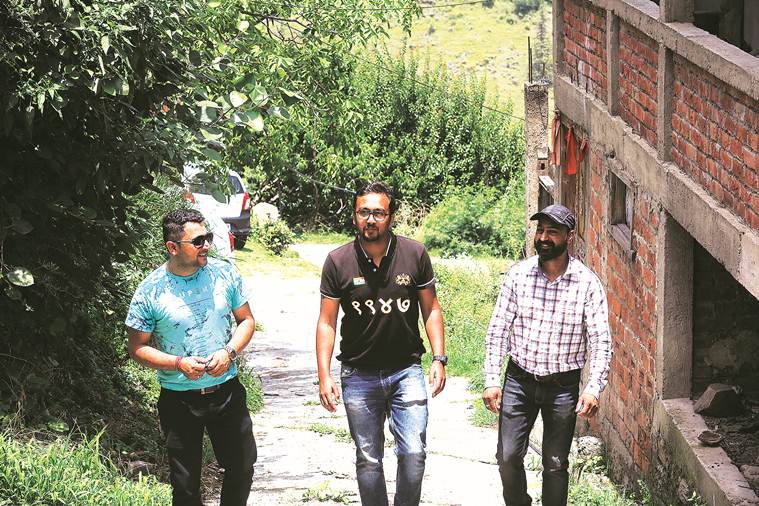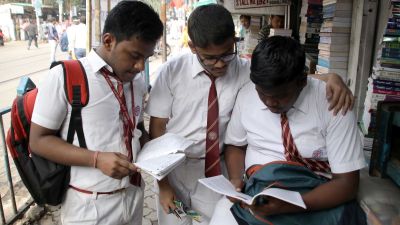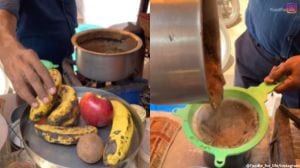- India
- International
An apple farm a day
What prompted a bunch of youngsters to quit their jobs and come back and grow apples on their family orchards in Himachal? Low input costs, good returns, allied revenue opportunities, and a nose for business.
 Suhail Chauhan at his apple farm in Matiana, about 40 km from Shimla. (Express Photo by Abhinav Saha)
Suhail Chauhan at his apple farm in Matiana, about 40 km from Shimla. (Express Photo by Abhinav Saha)
It is barely 11 on a foggy, rainy morning at an apple orchard in Matiana, over 40 km from Shimla, but half of Suhail Chauhan’s working day is over and he is now headed home. “Which other job can give you such returns? I live with my family and can give them time and attention. I breathe clean air and eat fresh food. And most importantly, I now make more money than I did while in a regular job,” says Suhail, who held a regular 9-to-5 job at a private university in Shimla until a little over a year ago but who is now an apple farmer.
Suhail, 29, is among several young men who have quit their jobs in metros to return to their villages and orchards in Himachal Pradesh’s Shimla district to grow apples.
Apples make up over 80 per cent of Himachal Pradesh’s Rs 3,500 crore fruit economy, with the fruit primarily grown in Shimla, Kullu, Kinnaur and Mandi districts. With 39,460 hectares, Shimla accounts for the highest area of the crop under cultivation.
Like with most other things in the state, the apple too comes with a colonial legacy. Captain A A Lee, a British Army soldier, is said to have planted the first apple tree in Kullu Valley in 1870. The apples, however, turned out sour and not many took to them. In the late 1880s, a few apple trees were planted by the British in Mashobra, 10 km from Shimla, then the summer capital of British India, but these were restricted to small private orchards.
It was Samuel Evan Stokes, an American missionary, who unwittingly introduced commercial apple cultivation in the state. Stokes brought a few grafts of the Red Delicious — then the most popular variety of apple in the US — to Kotgarh village, about 70 km from Shimla, in the early 1920s. Stokes married a Himachali woman, had children, converted to Hinduism and became Satyanand Stokes.

“When he brought the Red Delicious to Kotgarh, it was still patented in the US. No one knew it was being grown in a small village in Himachal Pradesh. In the 1940s and ’50s, the fruit gained acceptance. And after 1958, when the import of apples was regulated by then prime minister Jawaharlal Nehru, there was a boom in apple cultivation,” says 83-year-old Kotgarh resident Harichand Roach, among the few people to have interacted with Stokes. Roach owns a five-acre orchard in Kotgarh and an eight-acre orchard in Matiana, about 31 kilometres away.
 Kunal Chauhan (centre) along with two other orchard owners started a group called Progressive Growers Association in 2014, which was later turned into a cooperative. (Express Photo by Abhinav Saha)
Kunal Chauhan (centre) along with two other orchard owners started a group called Progressive Growers Association in 2014, which was later turned into a cooperative. (Express Photo by Abhinav Saha)
Suhail says his grandfather was among those who worked on Stokes’s farm. “Because apple cultivation was successful early on and there was good money, people were able to afford quality education for their children and started moving out to bigger cities. Some even bought land in nearby areas,” says Suhail, a third-generation apple orchard owner who owns three orchards — one each in Kotgarh, Kumarsen and Matiana, where he lives.
Speaking about what motivated him to quit his job as assistant registrar (administration) at APG University in Shimla and return home, Suhail says, “I used to live in a crowded part of Shimla and spent all the money I earned. Sometimes, I had to ask my parents for more. Today, I wake up at 6 am and stay in the orchard till 11 am. Then I am back at the orchard between 4 and 8 pm. But one needs to spend at least 300 days in a year in the orchard to get good returns,” he says.
While Suhail’s decision to come back to the orchard was a conscious one, 31-year-old Kunal Chauhan returned to his village in Kotkhai in different circumstances. After his degree in Computer Application from Chandigarh, he worked with Dell Technologies for eight months, before returning in 2010.
“My mother was unwell and I decided to return for a while to take care of her. But while I was here, I realised that there was a lot that I could do,” says Kunal, who has an ancestral farm of 57 bighas (one acre in Himachal Pradesh equals five bighas) in Kotkhai.
In 2014, he along with two other orchard owners started a group called Progressive Growers Association (PGA), which was then turned into a cooperative. “For our parents, the orchards were just another source of income while they worked in towns and cities. But for the people who are now returning, it is a full-time profession,” he says.
The cooperative grew from 88 members in the first year to 248 in five years, of whom 120 are below 35 years. The cooperative, which signed a memorandum of understanding with the Netherlands Embassy’s Agricultural Department and the Indo-Italian Chamber of Commerce and Industry, offers its members regular training sessions on pruning, cultivation techniques and the use of technology. Last year, the members sold six lakh boxes (each box of 25 kg) of apples in all.
“The bargaining power of a cooperative is more. We get fertilisers and machinery at a cheaper price. We now have a store of our own where we sell pesticides and fertilisers. A small percentage of the revenue is ploughed back into the cooperative. We have assets worth Rs 50 lakh. Our aim is to open a cold storage and a packaging unit,” says Kunal, who is general-secretary of PGA.
 A labourer at work at an orchard in Kotkhai in Shimla. (Express Photo by Abhinav Saha)
A labourer at work at an orchard in Kotkhai in Shimla. (Express Photo by Abhinav Saha)
But the younger generation of apple growers realised that it was not feasible to stick to old methods of cultivation. The trees, planted in the 1960s and 70s, were witnessing a decline in productivity. Besides, with China promoting apple cultivation — the country is the largest apple cultivator in the world — and imports eased, high-quality varieties of the fruit from the US and China started flooding the market. With the competition also came knowledge and newer varieties.
“For us, the easing of apple imports was a blessing in disguise. In the early 2000s, a box of our apples (25-30 kg) was selling for Rs 400-Rs 500. But when imported apples hit the market, their box sold for Rs 1,400-
Rs 1,500. That meant our apples also sold for a price around three times higher than before. That is when the money started flowing in,” says Kunal, who earns over Rs 32 lakh from his orchard every year. The input cost, he says, is only a fraction of that amount.
Young blood also meant newer ideas. While the older generation was happy growing the traditional Royal Delicious, the younger orchard owners are moving to newer varieties such as the Super Chief and Gala apple varieties.
In his farm, Suhail has around 200 trees of the Super Chief and 175 of the Royal Delicious. In all, he grows around 35 varieties, many of which are in the testing phase.
“If we use newer techniques such as spreading out the branches and making sure there is only one main shoot that grows upwards, we can ensure that more sunlight reaches the tree. This means more buds and thus more fruits,” says Suhail, adding that his 20-bigha orchard produced 2,000 boxes of apples last year, earning him around Rs 30 lakh. His input cost stood at only about Rs 4 lakh.
But it is not just apples that young growers are looking at as a source of revenue. Stone fruits such as cherries, apricots and peaches are fast becoming major revenue-generation options.
“The input cost for these fruits is negligible. Not much work is required and we barely spray any pesticides as there aren’t many pathogens in the area. In fact, they are almost organic. This year, Himachal saw a bumper cherry crop,” says Kunal, adding, “I have started growing blueberries and blackberries. It is difficult but the returns are very high. A kilogram of fresh blueberries sells for around Rs 1,500.”
The leaps in the transport industry have helped in ensuring that more of these perishable fruits reach the market on time. Over the last two decades, several cold storages have also come up in the region, but Arun Sharma, a 39-year-old orchard owner who earlier worked in hotels in Agra and Abu Dhabi before returning to Kotkhai in 2009, says only around 5 per cent of the produce is kept in storages.
Sharma, who has 10 bigha of ancestral land in Kotkhai, says his father was never interested in farming and the orchard lay unused for long. “I came home in 2009 as my mother fell ill. After she passed away, I decided to stay back,” says Sharma.
The youngsters are also exploring the opportunity of converting their ancestral homes amid orchards into homestays.
Parishrut Jhina left his job at a prominent patisserie in New Zealand to take care of his orchard in Domehar village, Kotkhai, where he started The Apple Farmstay. Set in the apple and pear farm owned by the Jhina family, the 100-year-old house has been renovated in the traditional pahadi style.
The 34-year-old is currently visiting New Zealand for a few months to complete the documentation process for permanent residency in the country.
“My son studied in Chandigarh and Mumbai, and then went to New Zealand. He stayed there for a few years but I am glad he decided that he found his calling,” says Parishrut’s father Digvijay Singh Jhina.
Over the years, while the area under fruit cultivation in Himachal Pradesh has grown, challenges loom in the form of ageing trees, climate change, non-availability of labourers, water shortage and poor accessibility.
“In many villages, connectivity is an issue. There is still no metalled road that leads to my orchard,” says Kunal. Suhail’s orchard, too, can only be accessed via a kuchcha road.
The effect of climate change is also being felt. According to many research papers, the belt viable for apple growth is shifting northwards.
“As a result, apples are now becoming the primary crop in areas like Chanshal and Rohru, which are at an altitude of 5,000 to 8,000 feet — higher than the ideal elevation. In the lower reaches of Kotkhai (around 5,500 feet), we are growing varieties that don’t require long chilling hours in winters,” says Kunal.
Shimla also faces an acute water shortage. “Orchards are still mostly rain-fed and there is little government support,” complains Sanjeev, who spent Rs 2 lakh on a rainwater harvesting pit near his orchard.
Nine years after he returned, Kunal says he has few regrets. “The only thing I miss a bit is meeting friends over the weekend,” he says. But what he rues is the societal pressure.
“A few years after I returned, my grandmother told me to go back and get an MBA degree. For her, qualification is still more important because that’s what people talk about. If someone thinks we are wasting our time here, they don’t understand the growth potential. I believe the best time is still ahead of us,” he says.
Suhail has a regret, though. “I should have come back sooner,” he smiles.
Apr 20: Latest News
- 01
- 02
- 03
- 04
- 05







































